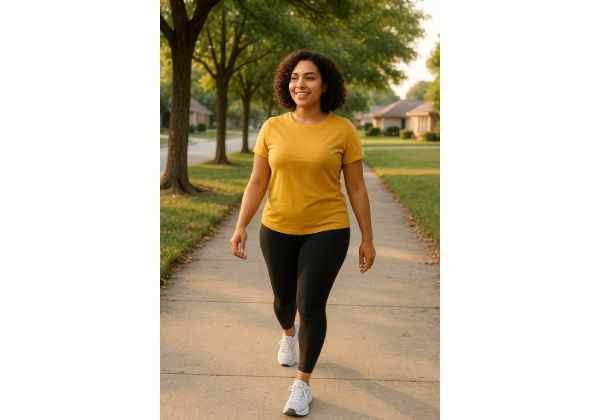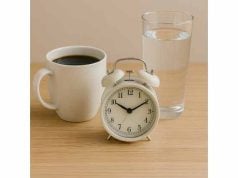
You do not need a gym membership or a long training plan to begin losing weight. A short walk after each meal can lower post-meal blood sugar, improve digestion, and help you create a daily calorie deficit—without feeling wiped out. In this guide, you will learn exactly how to start, the pace and timing that work best, how many calories you can expect to burn, and the common mistakes that stall progress. If you are building a broader routine that includes sleep, stress, and habit skills, see our primer on habits, sleep and stress basics. Use the steps and checklists below to begin tonight, turn walking into an automatic habit, and keep your joints and motivation intact.
Table of Contents
- Do 10-Minute Walks After Meals Work?
- How to Start Today in 3 Steps
- When to Walk and How Fast
- How Many Steps and Calories
- Common Mistakes to Avoid
- Who Should Be Careful
- Evidence and Results You Can Expect
- Frequently Asked Questions
Do 10-Minute Walks After Meals Work?
Short, easy walks after meals work because they leverage timing, not intensity. When you move within about 60 minutes of eating, muscles use circulating glucose for fuel. That reduces the “spike and crash” that can drive hunger and cravings later. The effect is practical: steadier energy, less snacking, and better control over total daily calories.
Walking also nudges insulin to work more efficiently. Muscle contractions open more “doors” (transporters) for glucose to enter cells—even at comfortable, conversational effort. Over time, this helps with appetite control and makes weight loss feel less like a willpower test.
Here is what a 10-minute, post-meal walk typically does for weight loss:
- Creates a small, repeatable calorie gap. A 10-minute walk burns roughly 25–50 calories for many adults, depending on body weight and speed. Three such walks add 75–150 calories of daily burn. That is 500–1,000 calories per week—enough to accelerate fat loss when paired with good nutrition.
- Blunts late-night grazing. Evening walks are especially helpful. By smoothing after-dinner blood sugar and providing a mental “off switch,” people often report fewer trips to the pantry.
- Preserves muscle and mood. Low-impact movement signals the body to keep muscle while you lose fat. It also reduces stress hormones that make cravings harder to manage.
To be clear, a 10-minute walk will not cancel out a surplus from large portions or high-calorie drinks. Think of walking as the simplest tool in a system that includes food quality, protein intake, sleep, and stress management. For a quick refresher on those fundamentals, see our guide to safe weight loss basics.
The best part is consistency. Very short walks are easy to fit in after breakfast, lunch, and dinner—even on busy days, in regular clothes, with no special gear beyond comfortable shoes. That “always doable” quality is what makes post-meal walking so effective over months, not just days.
How to Start Today in 3 Steps
You can begin tonight. Use this three-step plan to ensure your walks happen automatically and feel good from day one.
1) Anchor the habit to each meal.
Habits stick when tied to a reliable cue. Finish your last bite, stand up, set a 10-minute timer, and step outside or pace an indoor route. Keep the rule simple: eat → walk → resume your day. If you struggle with consistency, learn to stack a tiny habit onto something you already do, like making coffee or clearing the table.
2) Make the route friction-free.
Decide once, not daily. Choose a safe loop you can walk in work shoes or sneakers: down the block and back, around the parking lot, or up and down a hallway if weather is poor. Keep a light jacket and umbrella by the door. If evenings are hectic, take lunch-break loops and a short after-dinner indoor circuit.
3) Set a pace you could maintain for 30 minutes.
This is not a sprint. Use the talk test: you should speak in complete sentences without gasping. On a 0–10 effort scale (RPE), aim for 3–4. That intensity is ideal for using post-meal glucose while staying fresh enough to repeat the routine after every meal.
Practical tips that make it stick
- Start with one meal. If three walks feel like a lot, start with dinner only. After a week, add lunch, then breakfast.
- Use a 10-minute timer. Stopping at the bell prevents “too long, will skip tomorrow” thinking. If you feel good, add 2–5 extra minutes, but keep 10 as the minimum.
- Treat it like brushing your teeth. It happens regardless of weather, mood, or schedule. That mindset removes daily negotiation.
- Pair with an easy win. Sip water or herbal tea right after the walk to mark the habit and reduce cravings.
- Have an indoor fallback. March in place, walk stairs, or pace a hallway. Steps count wherever you take them.
What to expect in week one
Most people notice steadier energy after meals and less desire to graze at night. Feet and lower legs may feel more tired than usual for two or three days; that fades as the tissues adapt. If any joint pain persists beyond a week, shorten to 6–8 minutes, slow the pace slightly, and check your shoes.
Build momentum by tracking a simple streak: how many days in a row you completed at least one post-meal walk. Success fuels more success.
When to Walk and How Fast
Timing: Begin within 15–60 minutes after finishing a meal. The first 30 minutes are prime time for smoothing your glucose curve. If a meeting or commute gets in the way, any walking within an hour still helps.
Duration: Ten minutes is your minimum effective dose. If you feel good and have time, 12–15 minutes can provide a bit more benefit—especially after your largest meal.
Pace: Aim for a comfortable, brisk walk—fast enough to warm up but not breathless.
- Talk test: full sentences, no huffing.
- Rate of Perceived Exertion (RPE): 3–4 out of 10.
- Heart rate: often “Zone 1–2” for many adults; exact numbers vary, so do not fixate on them.
Terrain and posture: Choose flat, well-lit surfaces at first. Swing your arms, keep your gaze forward, and let your stride lengthen naturally. If hills are unavoidable, slow down on the climb to keep effort even.
What if you eat late?
A short, easy walk after dinner is still helpful and does not have to delay bedtime. Finish your walk at least 30–45 minutes before lying down. If reflux bothers you, keep the route flat and avoid bouncing or jogging.
Busy workdays:
Right after lunch, walk a timed loop around the building before you check messages. If you work from home, walk the block while listening to a saved playlist. Treat it as part of lunch, not an add-on you can skip.
Days with hard workouts:
Keep post-meal walks gentle. You do not need extra intensity on training days. The goal is circulation and glucose use, not fatigue. On rest days, you can extend one walk to 15–20 minutes if you enjoy it.
Appetite control:
Some people find that walking before a meal reduces hunger; others prefer after a meal to steady blood sugar and avoid dessert grazing. Experiment. For more on spacing meals to steer appetite, see meal timing for appetite.
Temperature and weather adjustments:
In heat, walk earlier or indoors. In cold, wear thin layers and keep routes short and repeatable. Wet or icy? March in place, walk hallways, or use a treadmill for 10 minutes.
Consistency beats perfection. The “right” timing and pace are the ones you will repeat most days of the week.
How Many Steps and Calories
Steps in 10 minutes: Most adults rack up 900–1,300 steps in ten minutes at an easy-brisk pace. Your stride length, height, and speed change the total, so treat those numbers as ballpark figures.
Calories burned: A typical 10-minute walk burns 25–50 calories for many people:
- Smaller bodies / slower pace: closer to 25–35 calories.
- Larger bodies / faster pace or slight hills: closer to 40–50+ calories.
Three short walks a day add 75–150 calories of extra burn. Over a week, that becomes 500–1,000 calories, which can make the difference between maintenance and steady fat loss when your food choices support the goal.
Where results really come from
- Walking prevents “creep.” Post-meal movement reduces the sleepy lull that leads to coffee, sweets, or second helpings an hour later.
- It compounds daily. Even on days you do not exercise, you still generate extra burn and better glucose control.
- It protects your deficit. When you eat a bit more at a social meal, a short walk keeps your weekly numbers closer to target.
Pair walking with simple nutrition rules
You do not have to count calories to see progress. Aim to center meals around lean protein and high-fiber plants and build plates by sight. If you want a low-math framework, see protein and plate method. This approach complements post-meal walks by improving fullness and making it easier to stop at “satisfied.”
What not to do with the numbers
Do not “eat back” calories from short walks; treat them as a bonus. Avoid chasing step counts so aggressively that you skip strength training or undermine sleep. And remember that watches and apps are estimates—use them to spot trends, not to micromanage exact calories.
If you enjoy data, track your seven-day step average rather than obsessing over any single day. A steady weekly average tells you far more about progress than a one-day spike.
Common Mistakes to Avoid
Turning a 10-minute walk into a workout.
The habit is meant to be light and repeatable. If you turn every stroll into interval training, you will skip more often, and your legs will feel heavy before dinner. Keep it easy.
Walking but ignoring portions.
Movement helps, but food drives the deficit. Big liquid calories or improvised snacks can erase the burn from several walks. If cravings spike, use quick fixes from our protein and fiber toolkit—a yogurt cup, a small handful of nuts, or chopped fruit does more than willpower alone.
Skipping because the day is “too full.”
A walk you do beats the perfect plan you skip. Ten minutes fits between calls, while the “ideal 45-minute session later” often vanishes. Set a phone reminder for ten minutes after meals until the routine feels automatic.
Only walking on “good” days.
The body responds to totals. Seven short walks in a week beat two long ones with five zero-movement days. Keep the streak by using indoor routes when weather or childcare gets in the way.
Letting gear become a barrier.
You do not need special shoes, a belt bag, or new leggings to begin. Comfortable footwear is enough. Upgrade later if you want.
Ignoring foot and joint comfort.
If arches ache, add a softer surface like a track or a park loop two or three days a week. If knees complain on downhills, shorten your route or choose flatter terrain. Persistent pain is a signal to adjust—not a reason to quit.
Expecting the scale to drop immediately.
In the first week or two, steadier energy and better digestion often show up before the scale moves. Track how many walks you complete and how your clothes fit. The weight trend follows the habit.
Who Should Be Careful
Most adults can safely add 10-minute, easy walks after meals. Still, check these considerations and adjust as needed.
- Foot, knee, or hip pain: Start with one walk per day at a slower pace. Try softer surfaces or supportive shoes. If pain persists more than a week, reduce duration to 6–8 minutes and consult a clinician or physical therapist.
- Diabetes or reactive hypoglycemia: Post-meal walking is often helpful for blood sugar. If you take insulin or medications that can cause low blood sugar, monitor levels, keep fast-acting carbs on hand, and discuss any new routine with your healthcare team.
- Peripheral neuropathy or poor sensation in feet: Choose smooth, well-lit routes and inspect feet daily. Consider indoor walking on even floors.
- Cardiovascular concerns: If you have chest pain, unexplained shortness of breath, or a history of heart disease, seek medical clearance before starting any new plan—even gentle walking.
- Pregnancy and postpartum: Many people can walk comfortably, but use a truly easy pace, avoid overheating, and stop if you feel pain or dizziness. Pelvic floor symptoms are a cue to slow down and shorten the route.
- Balance issues or dizziness: Walk with a partner, use indoor hallways, or consider a treadmill with handrails until confidence improves.
- Untreated sleep problems: Chronic fatigue makes consistency difficult. If snoring, daytime sleepiness, or morning headaches are present, review sleep apnea and weight loss and ask your clinician about evaluation.
Safety is simple: start small, listen to your body, and progress gradually. If you are unsure whether walking is safe for you, a brief check-in with your clinician is a wise first step.
Evidence and Results You Can Expect
Blood sugar control
Gentle post-meal walking consistently blunts glucose spikes compared with sitting. For many people, even 10 minutes helps, and 12–15 minutes after the heaviest meal can deepen the effect. Better control means fewer crashes, more stable mood, and less “urgent hunger.”
Appetite and cravings
Steadier glucose and a short break from the kitchen reduce the urge to graze. People often report that a 10-minute walk leads to easier portion control at the next meal and fewer sweet snacks at night.
Energy and digestion
Circulation improves after you move, which helps digestion feel smoother. Many notice less post-meal sluggishness—useful during workdays when you need to be alert after lunch.
Weight change timeline
If your food choices support a modest deficit, expect:
- Weeks 1–2: More consistent energy and fewer late-night snacks. The scale may hold steady or dip slightly as your body adjusts.
- Weeks 3–6: Noticeable changes in waist or clothes fit. A trend of 0.25–0.75 kg (0.5–1.5 lb) per week is realistic for many adults when walking is paired with protein-forward, high-fiber meals.
- Months 2–3: The habit feels automatic. You may add gentle strength work or extend one daily walk to 15–20 minutes if you like.
What success looks like
Daily steps climb without long workouts. Snacking becomes less reflexive. You feel fresher after meals. The routine survives busy weeks because it is quick and pleasant. And across months, that steady pattern supports meaningful fat loss without extremes.
Set your expectations on trends, not single days. If progress stalls for two to three weeks, check the basics: consistency (how many walks actually happened), portions, liquid calories, and sleep. Small, boring adjustments beat drastic changes.
Frequently Asked Questions
How soon after eating should I start my walk?
Begin within 15–60 minutes of finishing a meal. The first 30 minutes offer the biggest effect on post-meal blood sugar. If timing is tight, even a short walk anytime in the first hour helps. Keep the pace easy and conversational for best consistency.
Is a 10-minute walk long enough to matter for weight loss?
Yes. Ten minutes after each meal adds up to 30 minutes per day. That usually burns 500–1,000 extra calories per week and steadies appetite, which prevents overeating. The achievable consistency of short walks is what drives real-world weight changes.
Should I walk fast or keep it easy?
Keep it easy-brisk. Use the talk test—full sentences without gasping. On a 0–10 effort scale, aim for 3–4. You will use circulating glucose without building fatigue that makes you skip the next walk. Save harder efforts for separate workouts, if desired.
What if I cannot go outside after meals?
Walk indoors: pace hallways, march in place, climb stairs, or use a treadmill for 10 minutes. The benefits come from light, steady movement, not scenery. Decide on a default indoor route so weather or childcare never forces a skipped walk.
Do I need special shoes or gear?
No. Comfortable footwear is enough. If feet or knees get sore, rotate in a cushioned pair and favor flat routes. Bring a light jacket or umbrella so small barriers do not derail the routine. Start simple and upgrade later only if you want.
Will walking after dinner affect my sleep?
A short, easy walk usually improves sleep by aiding digestion and reducing stress. Finish at least 30–45 minutes before bed and keep the route gentle. If reflux or discomfort occurs, choose flatter terrain, slow the pace, and allow extra time before lying down.
References
- Positive impact of a 10-min walk immediately after glucose intake on postprandial glucose levels 2025 (RCT)
- After Dinner Rest a While, After Supper Walk a Mile? A Systematic Review with Meta-analysis on the Acute Postprandial Glycemic Response to Exercise Before and After Meal Ingestion in Healthy Subjects and Patients with Impaired Glucose Tolerance 2023 (Systematic Review)
- 5. Facilitating Positive Health Behaviors and Well-being to Improve Health Outcomes: Standards of Care in Diabetes-2025 2025 (Guideline)
- WHO guidelines on physical activity and sedentary behaviour 2020 (Guideline)
- 2024 Adult Compendium of Physical Activities: A third update of the energy costs of human activities 2024
Disclaimer
This content is for educational purposes only and does not replace personalized medical advice, diagnosis, or treatment. Always consult a qualified healthcare professional about your specific health conditions, medications, and exercise readiness, especially if you have diabetes, heart, joint, or balance issues.
Share and Follow
If this guide helped you, consider sharing it with a friend or family member who wants a simple way to start losing weight. You can also follow us on Facebook, X, or whichever social network you prefer for practical tools you can use right away.










